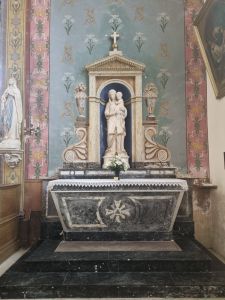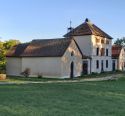Church | 1734 | Classical | Catholic Church





Map
Opening hours
24 April - 28 September
Mon
Tue
Wed
Thu
Fri
Sat 10.00 - 18.00
Sun 10.00 - 18.00
Religious offices
Description
In recognition of this French heroine's actions, King Charles VIII exempted the two towns of Domrémy and Greux from taxes. The commune of Greux retained this privilege until 1766, while Domrémy lost it in 1571 when it was annexed to the Holy Roman Empire.
Nothing remains of the church that Joan of Arc knew. The current Saint-Maurice Church, which stands on the town's main street, dates from the 18th century, the previous one having been destroyed during the Thirty Years' War. During reconstruction, a new location was chosen, more convenient for residents than the hillside. Today, statues mark the site of the former building.
What strikes visitors as they enter the classical-style Saint-Maurice Church is its authenticity. As the villages of Domrémy and Greux have always functioned together, the inhabitants have taken greater ownership of the places of worship in the neighbouring village. This has enabled the church in Greux to preserve all of its 18th-century furnishings and decoration, which have remained intact despite the passage of time and changes over the years.
Photos
Remarkable elements
Stained glass windows depicting Saint Joan of Arc
Two stained glass windows, each located in a side aisle, depict the story of Joan of Arc.
In the south aisle, the stained glass window shows Joan of Arc praying before the Virgin and Child in the Chapel of Our Lady of Bermont in Greux.
Opposite, in the north aisle, the stained glass window depicts Joan surrounded by her voices: Saint Catherine, Saint Margaret and the Archangel Saint Michael. The saints present her with a sword. In the background, you can see Joan's birthplace in Domrémy and the village church.
Portal
The church is built on a basilica plan, consisting of a nave and two aisles. Its sober architecture is enhanced by a classical-style portal. This is decorated with two composite columns supporting a floral frieze, framed by an IHS, short for Iesus Hominum Salvator, “Jesus Saviour of Mankind”, and a crowned AM for Ave Maria, “Hail Mary”.
The ensemble is dominated by a representation of Saint Maurice, a Roman soldier and patron saint of mercenaries. This iconographic choice, in keeping with the church's dedication, also recalls the history of the village, which was once a stopping place for mercenary troops.
Baptismal font
The only elements that Joan of Arc probably knew in the church of Greux are the 14th-century carved stone baptismal font. Octagonal in shape, it is decorated with arches and floral motifs.
Holy water font
The holy water font rests on an ancient column, the origin of which is unknown. It may have come from the previous church in Greux, as the reuse of materials was common practice during reconstruction.
Jean Jacob
The parish priest of the villages of Domrémy and Greux supervised the reconstruction of the church in Greux. Two elements, now protected as historic monuments, commemorate his work.
In front of the choir, a tombstone from 1738 invites villagers to pray for the soul of this priest, who died a year earlier and was their parish priest for seventeen years. A chalice is engraved on it, recalling his priesthood.
On the north wall of the church, a richly decorated 18th-century tombstone also pays tribute to him.
Nearby
Circuit
Flora in churches

For the first time since the creation of the exhibition on flora in churches, the panels will travel to churches in Haute-Marne and Vosges (members of the network) from March 2025 to January 2026...




















